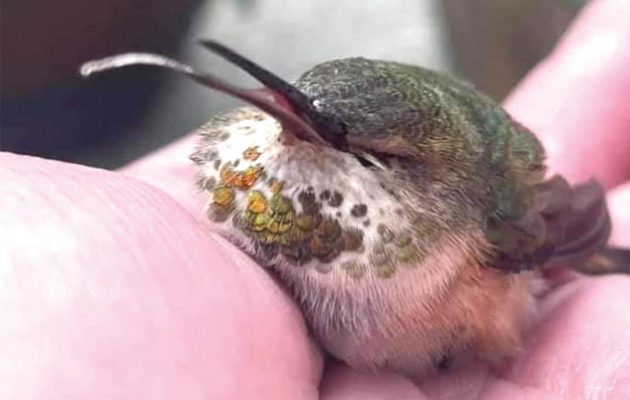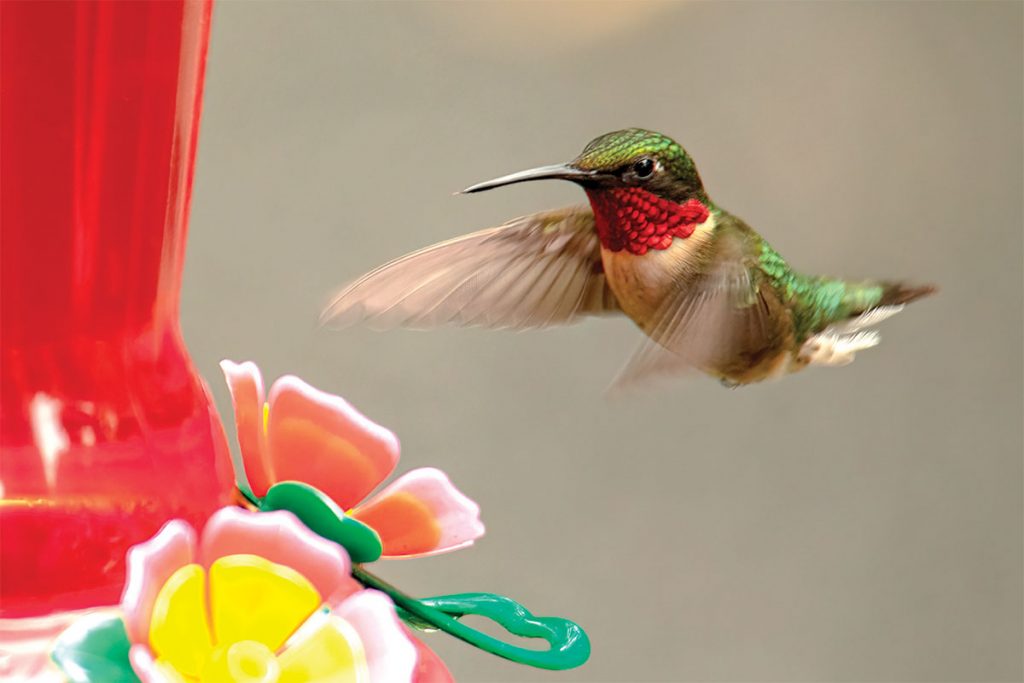Animal House: HUMMINGBIRDS

Hummingbirds flash their tropical parrot feathers of metallic emerald green, ruby red, and silver-gray as they zoom across Jacksonville yards. Their flight speeds are so fast, the eye can barely follow. Homeowners or gardeners can easily attract these fascinating, tiny acrobats and help keep the fragile birds safe and healthy.
Hummingbird feeders provide unlimited opportunities to watch hummingbirds feed, court, compete for mates, rest, and play. The tiny birds will remain close to clean, filled sugar-water feeders, especially if everything else they need is nearby. They require a clean water source, prefer dripping water or mist, and bathe frequently. They need perches, nearby shrubs or trees for shelter and nesting, abundant insects, and flowering nectar blossoms for food. Evergreen shrubs or trees provide safe cover for hummingbirds that remain in Jacksonville year-round.
Ornithologists who study hummingbirds warn against using any ingredient other than plain, white granulated sugar in homemade mixtures for hummingbird feeders. The only safe recipe for hummingbird sugar-water is one part plain, white sugar, and four parts water. Adding more sugar is harmful because it speeds up the growth of mold and bacteria. Use warm water or briefly boil to remove suspected impurities. Stir to dissolve the sugar and completely cool before pouring it into the feeder.
Bacteria or mold in the mixture or on the feeder can cause swelling or the growth of fungal spores on a hummingbird’s tongue: both fatal. These contaminants cause visible fungal spores to grow on and around the tongue and prevent the bird from feeding. The condition will not heal and rapidly causes a painful death from starvation and dehydration.
Never use honey, molasses, organic, raw, brown, powdered, or artificial sugar in the sugar-water mixture. Do not add food color or dye; natural flower nectar is clear. Do not add Kool-Aid, juice, vitamins, coconut or flavored water, or other additives.
Sugar-water solutions must remain fresh, which is difficult in Florida weather. Clean feeders with hot water every four days during warm, humid weather and every week at other times. According to The National Audubon Society, it is safest to use hot water or a weak vinegar solution to clean the feeder and thoroughly rinse. Do not use soap or chlorine bleach, which leaves a residue that is difficult to remove and harms hummingbirds.
Discard leftover sugar-water at each cleaning. Within 4-7 days, extreme heat or humidity can cause the sugar-water to become contaminated by mold or bacteria: deadly to hummingbirds.
Sugar-water provides extra sustenance for these birds that must work every daylight moment to fuel their supercharged metabolism. They feed every ten or fifteen minutes, most heavily at dawn and dusk, and sip from approximately 1,000-2,000 flower blossoms daily.
Overnight, hummingbirds go into a torpor state (hibernation-like deep sleep) that allows them to survive without food for hours. Their body temperature, metabolism, and heart rate drastically drop. At dawn, they must immediately feed.
Their long, slender needle-like bill and tongue can reach far into flowers to extract nectar. The last half-inch of the tongue is divided into equal halves. Each half is grooved on the outer edges to form two tubes that act like straws to suck in the nectar.
Hummingbirds are expert aerial hunters and feed on live invertebrate insects like flies, spiders, gnats, aphids, and mosquitoes. Insects are an essential protein source and primary food for their young.
Homeowners and gardeners should select flowering plants for the hummingbird garden that bloom from March to September. Leave broken-off branches or sticks from trees, shrubs, or plants undisturbed. These provide perfect natural perches for hummingbirds.
Plant bright red, orange, yellow, and pink native flowering plants, vines, shrubs, and trees to attract hummingbirds. Tubular blossoms, which hold a rich pool of nectar at their base, are favorites. The birds learn which flower colors provide the highest quality nectar that is their best nutrition source. The National Audubon Society has reported that native plant blossoms provide more nectar and attract more insects that hummingbirds feed on than hybrid, ornamental or exotic flowers.
Some favorite hummingbird blossoms include blooming aloe plants, beebalm, butterfly bush, gaura, hibiscus, honeysuckle, firebush, firespike, cross vine, trumpet vine, flowering jasmine, milkweed, porterweed, morning glory, sage, shrimp plant, bottlebrush and cassia trees. Overripe fruit or banana peels placed in a basket hung close to a hummingbird feeder will attract fruit flies: a hummingbird treat.
Hummingbird sugar-water feeders are available in all styles and price ranges. The clear, glass feeders with perches are recommended. These are easiest to clean, and the glass allows a clear view of any mold growth, cloudiness, dead insects, or other contamination inside. Perches encourage the birds to pause and feed or rest for optimal viewing. Choose bee and ant guard options which are helpful. Feeders hung under an overhang or another cover can avoid overheating and rain. Loud wind chimes, bells, and flapping flags frighten hummingbirds.
Bees that swarm hummingbird feeders to sip dripping sugar-water discourage the birds. Still, like hummingbirds, they are also important pollinators. Yellowjackets that nest underground can be the most aggressive around the feeders and are difficult to thwart.
Ants will quickly discover the feeders, enter if they can, and foul the water. Do not use Vaseline, oil, or sticky substances on hanging hooks or poles to deter or trap nuisance insects because these products may harm or injure hummingbirds.
Hummingbirds can become territorial and aggressive around their feeders. The easiest solution is to provide a second feeder at a ten-foot distance from the first.

Hummingbirds are the world’s smallest birds at just 1/10th of an ounce or about the weight of a penny and two to three inches in length. They have two sets of tail feathers. The two center feathers are green, and the eight outer feathers are black. Females and juveniles have white tips on their black tail feathers. Males lose their white tips at maturity.
Hummingbird nests are the size of a large walnut, a ping pong, or a golf ball. A female hummingbird will choose a nest site ten to ninety feet high in a tree. She then gathers soft materials and builds the nest herself. The nest is attached to the tree with spider webbing, and then the interior is carefully lined with plant down, lichen, moss, or fine plant fiber.
After her nest is built, the female hummingbird will mate. After mating, the male hummingbird has no contact with the female, the nest, or the babies. The female lays two eggs the size of jelly beans that she sits on for approximately twenty days. Once hatched, the hummingbird babies are fed live insects for four weeks and nectar just before they leave the nest.
Surprisingly, these mesmerizing birds have an outsized reputation for speed, unbelievable stamina, and endurance in the bird world. They can hover, suspended in the air like miniature helicopters, and are the only bird that can fly straight up, backward, and upside down. They cannot glide or soar. Their unique flight abilities are made possible by wings that rotate and move in any direction from the shoulder.
Hummingbirds make a sound similar to humming, but the sound is made by their wings beating 50 – 200 times per second. The wings beat so rapidly they are blurred. Each hummingbird species has a distinctive vocal chirp and all have been recorded. Many can be heard on The National Audubon Society website.
These birds have a brain programmed to navigate the longest migrational flight ever recorded, based upon their comparative size and distance traveled. Each winter, they fly to Mexico and South America, a flight triggered by a specific change in the length of day and angle of the sun. Some remain year-round in warm parts of the southern U.S. They begin the migration north to breed, nest, and raise young in March.
Of approximately 338 known hummingbird species in the world and eighteen in the U.S., there are three species most often seen in Florida: Ruby-throated, Rufous, and Black-chinned hummingbirds. It is possible to spot other seasonal, migratory, or rare hummingbirds in North Florida.
Hummingbirds live an average of three to five years but face constant dangers. They die from pesticides, insecticides, and mosquito spraying on contact. It is fatal if they feed, drink, bathe, or contact flowers, food crops, landscape plants, insects, and water sources contaminated with poisons.
Predators are a daily threat to hummingbirds and include outdoor domestic and feral cats, hawks, owls, and praying mantis. Blue jays, crows, and squirrels devour hummingbird eggs and babies.
Development destroys the wooded forests, meadows, and grasslands hummingbirds need for shelter, food, nesting, and raising their young. Those living in urban areas struggle to find enough uncontaminated nectar plants and often crash into glass windows with no decals or other visual alerts to prevent bird strikes.
By Julie Kerns Garmendia
Resident Community News







